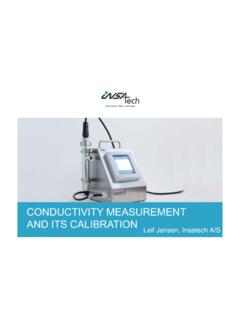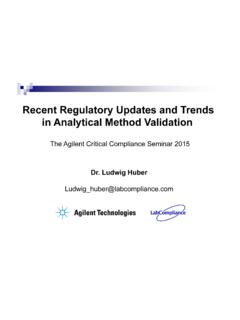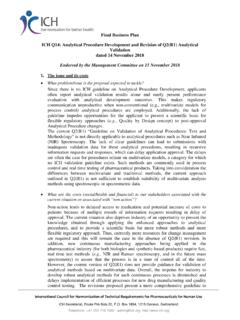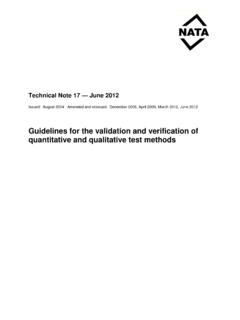Transcription of Reasons, Regulations, and Rules: A Guide to the Validation ...
1 18 PHARMACEUTICAL ENGINEERING MAY/JUNE 2001 The Validation Master PlanReasons, regulations , and Rules: A Guide to the Validation MasterPlan (VMP) reasons , regulations , and Rules: A Guide to the Validation MasterPlan (VMP)Tby Brian W. SaxtonThis articledescribes theelementalrequirements ofa ValidationMaster Plan(VMP), what itshould look like,what level ofdetail should beincluded, US Food and Drug Administration(FDA) has been explicit in the need forvalidation, but implicit on the elementsof that program. The chanting of the thou shaltvalidate mantra is heard throughout the Drug,Biologics, and Medical Devices sections of theCode of Federal regulations (CFR), but, alas,there is no boilerplate template to follow. Orga-nizations are thus left to interpret the regula-tory requirements and craft individual programsto comply. Is there a guiding principle that canbe applied here, to help companies distill reamsof mind-numbing regulations into elementalvalidation requirements?
2 An adage about public speaking says thereare three keys to a successful presentation:1. Tell them what you re going to Say Tell them what you adage, in a slightly modified form, can beused to describe the major elements of a Valida-tion Program:1. Tell them what you re going to Do Tell them what you three-step outline is a greatly simplifiedmodel of the multitude of tasks associated witha Validation program, but is an accurate sum-mary of the goals of each step of the process. Therole of the Validation Master Plan is to help anorganization get its arms around a project-specific Validation effort by setting the scope bywhich all subsequent documents shall see how the parts of the Validation pro-gram fit into this modified adage, let s brieflyreview the elements. Validation Program isan umbrella term, encompassing all of the com-ponents below - Table Master Plan (VMP)The VMP serves as the Validation roadmap,setting the course, justifying the strategy, out-lining the preliminary test and acceptance cri-teria, and documenting the necessary programsthat ensure a continuing state of Qualification phase provides documenta-tion that equipment and utility systems wereinstalled properly through an Installation Quali-fication (IQ), operate correctly through an Op-erational Qualification (OQ), and perform effec-tively through a Performance Qualification (PQ).
3 Qualification assures that the criteria set forthin the Basis of Design documents generated atproject inception have been met in the ValidationBuilding on the data generated from the Quali-fication phase, the Process Validation (PV) phasefocuses on the reproducibility of the systemsused and the resulting product quality. Thisprogram challenges the ability of the systemsused (methods, equipment, and operators) tomeet the pre-approved design ReportsFinal Reports (FR) compare the conclusions ofdata gathered to the acceptance criteria out-lined in the Qualification and Validation determine the pass/fail status and ad-dress the resolution of any deviations. They alsocan be referred to as Summary ProgramsThe Validation program must ensure policiesand procedures comply with current Good Manu-facturing Practices (cGMP). Systems such ascalibration, preventative maintenance, changecontrol, and revalidation contribute to a con-tinuous state of fromThe Official Journal of ISPEPHARMACEUTICAL ENGINEERING May/June, 2001 Vol.
4 21 No. 3 Copyright ISPE 2001 MAY/JUNE 2001 PHARMACEUTICAL ENGINEERING19 The Validation Master PlanConsidering the above, we can now complete the ValidationProgram adage:1. Tell them what you re going to do (VMP).2. Do it (IQ/OQ/PQ/PV).3. Tell them what you did (FR).This article will focus on the Tell them what you re going to do part of the Validation Program, otherwise know as the Valida-tion Master OverviewThe purpose of the VMP, in a prospective or concurrent valida-tion effort, is to explain the Validation rationale associatedwith the installation, start-up, and use of a new productionline. This rationale should review manufacturing systems andassess the potential of each to affect end-product quality. Thenew process may be as simple as an accessory change onexisting product equipment, or as complex as a new buildingwith all new utilities and equipment. The size and scope of theproject determines the size and scope of the resulting VMP.
5 Fora retrospective Validation effort, the VMP documents theexisting production line and outlines the anticipated test andanalytical methodologies to be VMP should be authored for its audience, including theorganization s quality, engineering, and regulatory depart-ments, the FDA, and potential outside contractors. Each grouplooks for different elements. Outside contractors want aDeliverables List on which to base quotes and define the scopeof work; the FDA looks for the pre-approved intention tocomply with Federal regulations ; while in-house quality, engi-neering, and regulatory departments look for an accuraterepresentation of systems and corporate policies. The VMPshould address all of these VMP serves the purpose of documenting the intent ofthe Validation program, and therefore needs to be pre-ap-proved by the same departments that will ultimately beresponsible for reviewing and approving the subsequent proto-cols.
6 At a minimum, this includes Regulatory Affairs, Quality,and a Dialogue with the FDAT here are a number of good reasons to create a VMP: the FDA sexpectation that one be created, determining resource sched-uling and loading, and defining the necessity to create oramend corporate procedures. However, one function of theVMP is often underutilized: serving as a vehicle to open updialogue between the regional District Office of the FDA andthe organization. Initiating a pre-submission meeting with theFDA to review the VMP will save time to market by addressingany concerns about the Validation philosophy or methodologyup front, when the correction of those issues is not on a criticalpath for time to market. This allows companies to work withthe FDA in an advisory versus an enforcement mode, whichwill help take some of the anxiety out of the Validation processand improves its chances of success. The FDA s Center forBiologics Evaluation and Research (CBER) has published adocument through its Manual of Standard Operating Proce-dures and Policies that discusses this.
7 It suggests that a briefdescription of the Validation procedures including the valida-tion master plan 1 be submitted for review prior to the pre-NDA (New Drug Application) meeting. Although this proce-dure was written for Biologics, the benefits of such meetingsfor Drug and Medical Device products is obvious, particularlyif there are unique processing steps and/or equipment that theaverage FDA compliance officer may not be familiar References to Validationand PlanningThe FDA can determine prohibited acts and penalize drug anddevice manufacturers who market adulterated Anadulterated product is one whose quality characteristics cannot be satisfactorily assured due to nonconformity with cur-rent Good Manufacturing Practices (cGMPs)3. The definitionof adulterated product is straightforward, but preventing itsoccurrence can be complex. In essence, a Validation Programensures that systems, policies, and procedures exist to preventthe manufacturing of adulterated products.
8 It s in the cGMPsfor Drugs (21 CFR 210 & 211), Biologics (21 CFR 600) andDevices (21 CFR 800) where the need for Validation is ProductsFor drug products, Parts 210 and 211 of the cGMPs referloosely to maintaining appropriate Validation data. How-ever, the practice of Validation is implied more strongly in (a): Automatic, mechanical, or electronic equipment orother types of equipment, including computers, or relatedTable A. Validation Program Validation Master Plan (VMP) Documents Intent and Pathway Qualification (IQ/OQ/PQ) Confirms Design Intent Process Validation (PV) Assures Process Consistency Final Reports (FR) Summarizes Test Results vs. Acceptance Criteria Compliance Programs Ensures Continuing State of ValidationTable B. Typical VMP VMP Contents1. Introduction2. Scope3. Facility Description4. Commissioning5. Qualification6. Process Validation7. Computer System Validation8. List of Required Protocols and Procedures9.
9 List of Required Standard Operating Procedures10. Equipment and Utility System Descriptions11. Computer System Description12. Other cGMP Programs13. References Copyright ISPE 200120 PHARMACEUTICAL ENGINEERING MAY/JUNE 2001 The Validation Master PlanTable C. List of required protocols and Equipment/Other System Series 10099999 Centrifuge99999 Catch Tank9 Solvent Storage and Distribution99999 Glass Lined Mix Tank and TCU99999 Utility SystemsUTILITY Water System9 Breathing Air System9 Cold Glycol System9 USP Water System99999 HVAC99999 LegendComm.: CommissioningIQ: Installation QualificationOQ: Operational QualificationPQ: Performance QualificationPV: Process ValidationNot Applicablesystems that will perform a function satisfactorily, may beused in the manufacture, processing, packing, and holding ofa drug product. The burden of proof lies with the manufac-turer to show equipment will perform a function satisfacto-rily, and that proof should take the form of in-process testingor alternately, Process clarify the Validation requirements implicit in thisregulation, the Agency issued a Federal Register Notice pro-posing changes to Parts 210 and One change would offerthis definition: Validation protocol means a written plandescribing the process to be validated, including productionequipment, and how Validation will be 5 Anotherproposed section states: The manufacturer s determination ofequipment suitability shall include testing to verify that theequipment is capable of operating satisfactorily within theoperating limits required by the process.
10 6 In both of thesecases, a well-crafted VMP will show the Agency the pre-approved intent to comply with the expectations of Biologics, Part 600 addresses unique considerations asso-ciated with biological products and blood components. Biologi-cal-derived drug products must adhere to Parts 210 & , cGMP section requires Validation for changes toan approved application. Before distributing a product madeusing a change, an applicant shall demonstrate through appro-priate the lack of adverse effect of the change onthe identity, strength, quality, purity, or potency of the 7 This requirement governs changes in ..product, pro-duction process, quality controls, equipment, facilities, re-sponsible personnel, or 8 Whether the change ismajor or minor, a VMP will provide the Agency the basiccomponents of the organizational Validation philosophy andintentions to comply with applicable DevicesFor Medical Devices, 21 CFR 820 serves as the cGMP require-ments section.







